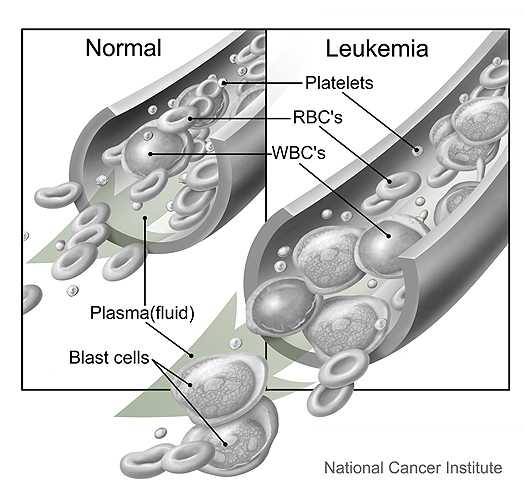Leukemia

This drawing shows normal blood cells and blood cells with leukemia. Platelets, red blood cells (RBC’s), white blood cells (WBC’s), plasma (fluid), and blast cells are labeled. Click to see a larger diagram.
Image courtesy National Cancer Institute.
Leukemia is a cancer of the bone marrow (the soft, sponge-like tissue in the center of most bones that makes blood cells) and blood. The two main kinds of leukemia are—
- Lymphocytic leukemia (also known as lymphoblastic leukemia), is when the body makes too many of a certain kind of white blood cells, called lymphocytes.
- Myelogenous leukemia (also known as myeloid or myelocytic leukemia), is when the body makes too many of a certain kind of white blood cells, called granulocytes.
Leukemia can be acute or chronic. Acute types of leukemia progress quickly, while chronic types of leukemia progress slowly, leading to different treatments.
Leukemia is the most common kind of cancer among children and teens. Acute lymphocytic leukemia is more common among children and teens than among adults. However, because other types of leukemia become more common with age, most leukemia is found in among adults.
What Causes Leukemia?
Scientists do not fully understand all of the causes of leukemia, but research has found many links. For example—
- Being exposed to benzene or large doses of ionizing radiation have caused leukemia in some people.
- Tobacco smoke contains cancer-causing chemicals (including benzene), which are linked to acute myeloid leukemia in adults.
- Family history also has been linked with higher risk of some kinds of leukemia, such as chronic lymphocytic leukemia.
- Some people with Down syndrome or blood disorders such as polycythemia vera (a disease in which there are too many red blood cells in the bone marrow and blood, causing the blood to thicken) may be more likely to develop leukemia.
- Most people with chronic myelogenous leukemia have a gene mutation (change) called the Philadelphia chromosome. It results in the bone marrow making an enzyme that causes too many stem cells to become white blood cells. The Philadelphia chromosome is not passed from parent to child.
- White people are more likely than black people to develop lymphocytic leukemia, but scientists do not know why. Scientists also do not know why men are more likely than women to develop leukemia.
What Are the Symptoms of Leukemia?
Chronic lymphocytic leukemia usually does not cause any symptoms and is usually found during a routine blood test. If it does cause symptoms, they can include swollen lymph nodes and feeling tired. Symptoms of chronic myelogenous leukemia include fever, night sweats, and feeling tired. Sometimes chronic myelogenous leukemia does not cause any symptoms.
The early symptoms of acute myelogenous leukemia and acute lymphocytic leukemia may be like those caused by the flu or other common diseases. Symptoms include fever, night sweats, feeling tired, feeling out of breath, and bruising or bleeding easily.
These symptoms can also come from other conditions. If you have any of them, talk to your doctor.
Statistics
In the United States in 2014 (the most recent year for which numbers are available)—
- 47,135 people (27,489 men and 19,646 women) were diagnosed with leukemia, and 23,564 people (13,542 men and 10,022 women) died from it.
- Among men, white men had the highest rate of developing leukemia (17.5 per 100,000 men), followed by black men (13.0), Hispanic† men (12.3), Asian/Pacific Islander men (9.4), and American Indian/Alaska Native men (9.2).
- Among women, white women had the highest rate of developing leukemia (10.6 per 100,000 women), followed by Hispanic† women (8.9), black women (8.4), Asian/Pacific Islander women (6.2), and American Indian/Alaska Native women (5.3).
†Hispanic origin is not mutually exclusive from race categories (white, black, Asian/Pacific Islander, American Indian/Alaska Native).
Data source: U.S. Cancer Statistics Working Group. United States Cancer Statistics: 1999–2014 Incidence and Mortality Web-based Report. Atlanta (GA): Department of Health and Human Services, Centers for Disease Control and Prevention, and National Cancer Institute; 2017. Available at: http://www.cdc.gov/uscs.
More Information
- Cancer Among Children (CDC)
- Leukemia (National Cancer Institute)
- What You Need to Know About Leukemia (National Cancer Institute)
- Leukemia (National Institutes of Health)
- Adult Acute Leukemia (Medline Plus)
- Adult Chronic Leukemia (Medline Plus)
- Childhood Leukemia (Medline Plus)
- Leukemia (Leukemia & Lymphoma Society)
- Leukemia (American Cancer Society)
- Page last reviewed: September 25, 2017
- Page last updated: September 25, 2017
- Content source:


 ShareCompartir
ShareCompartir